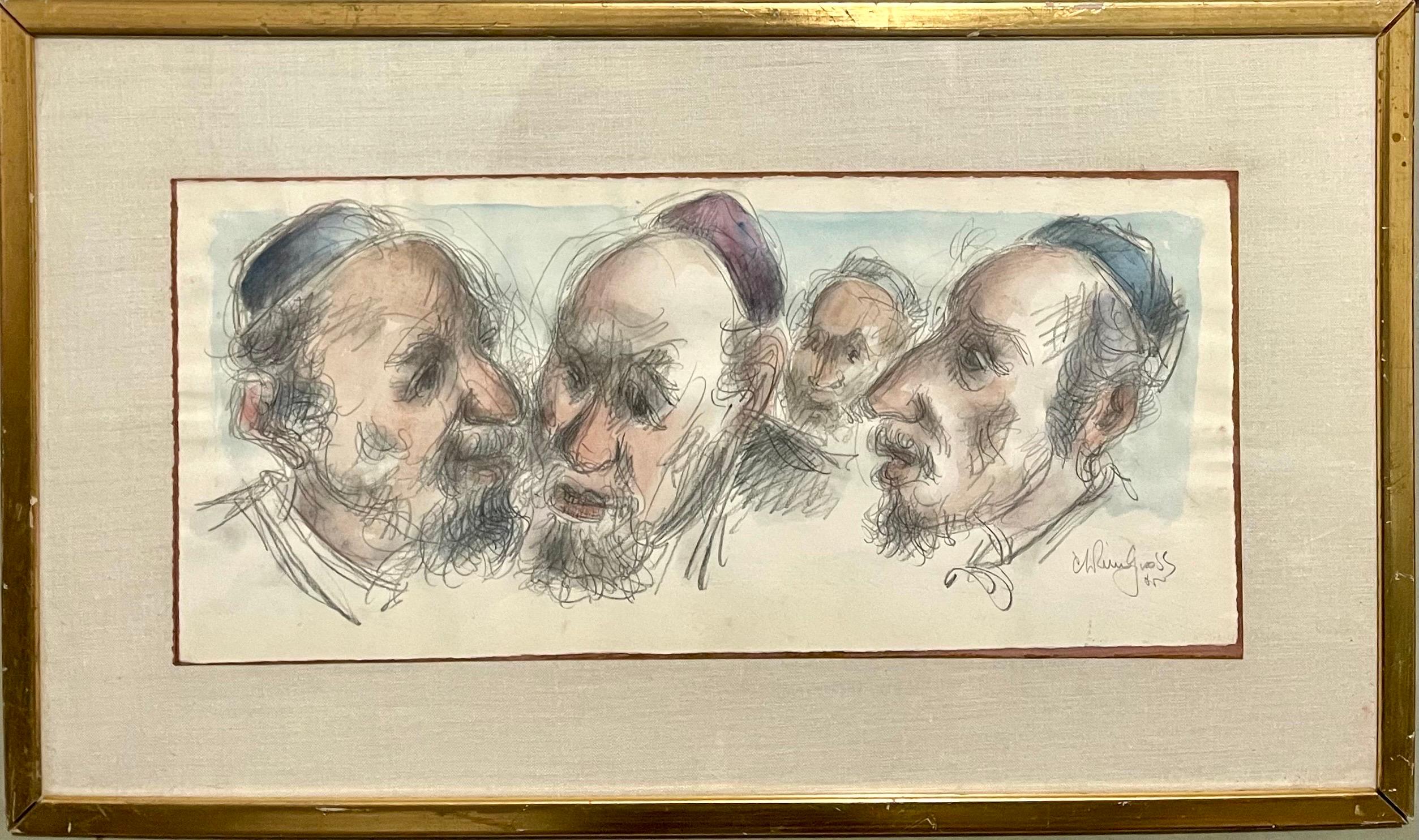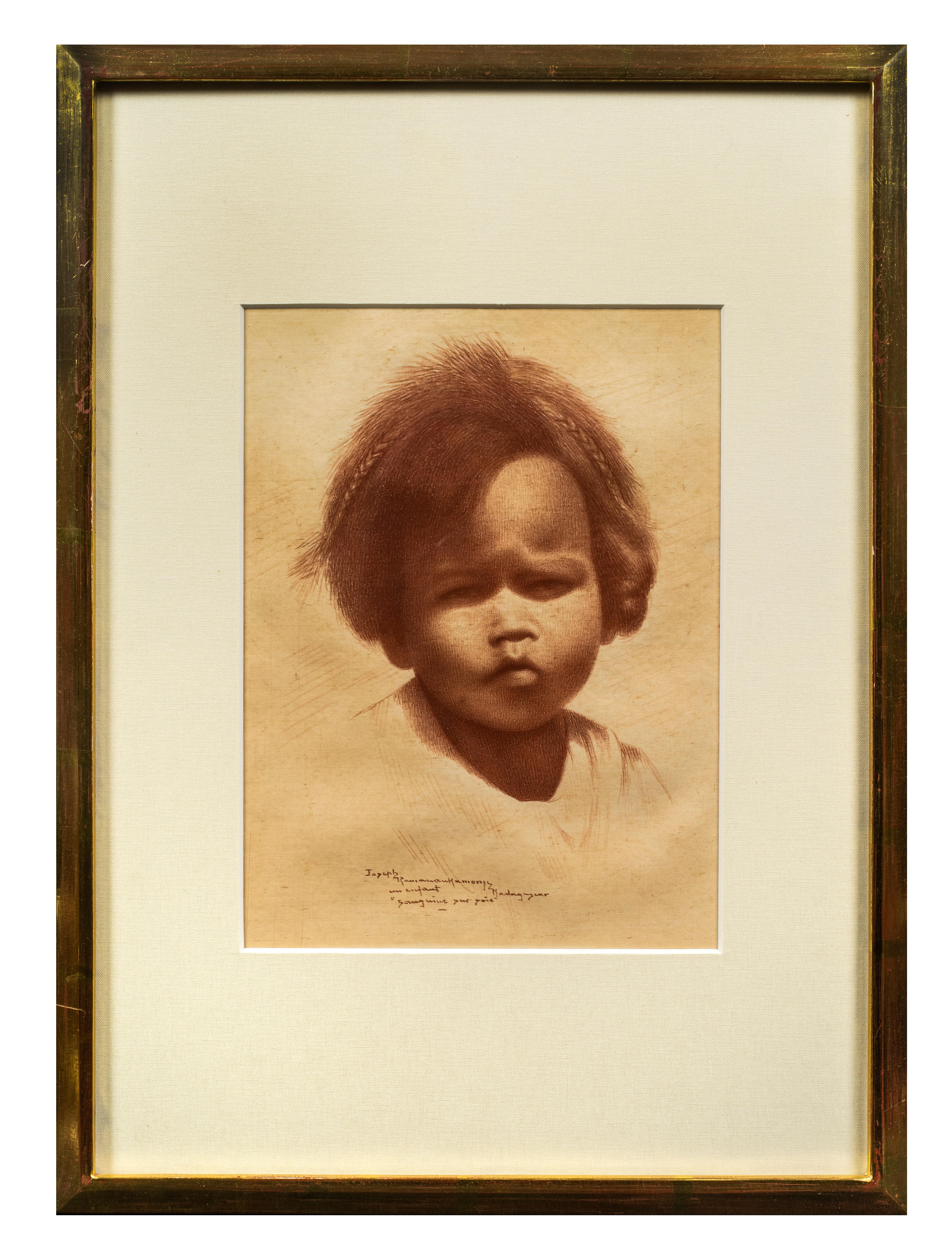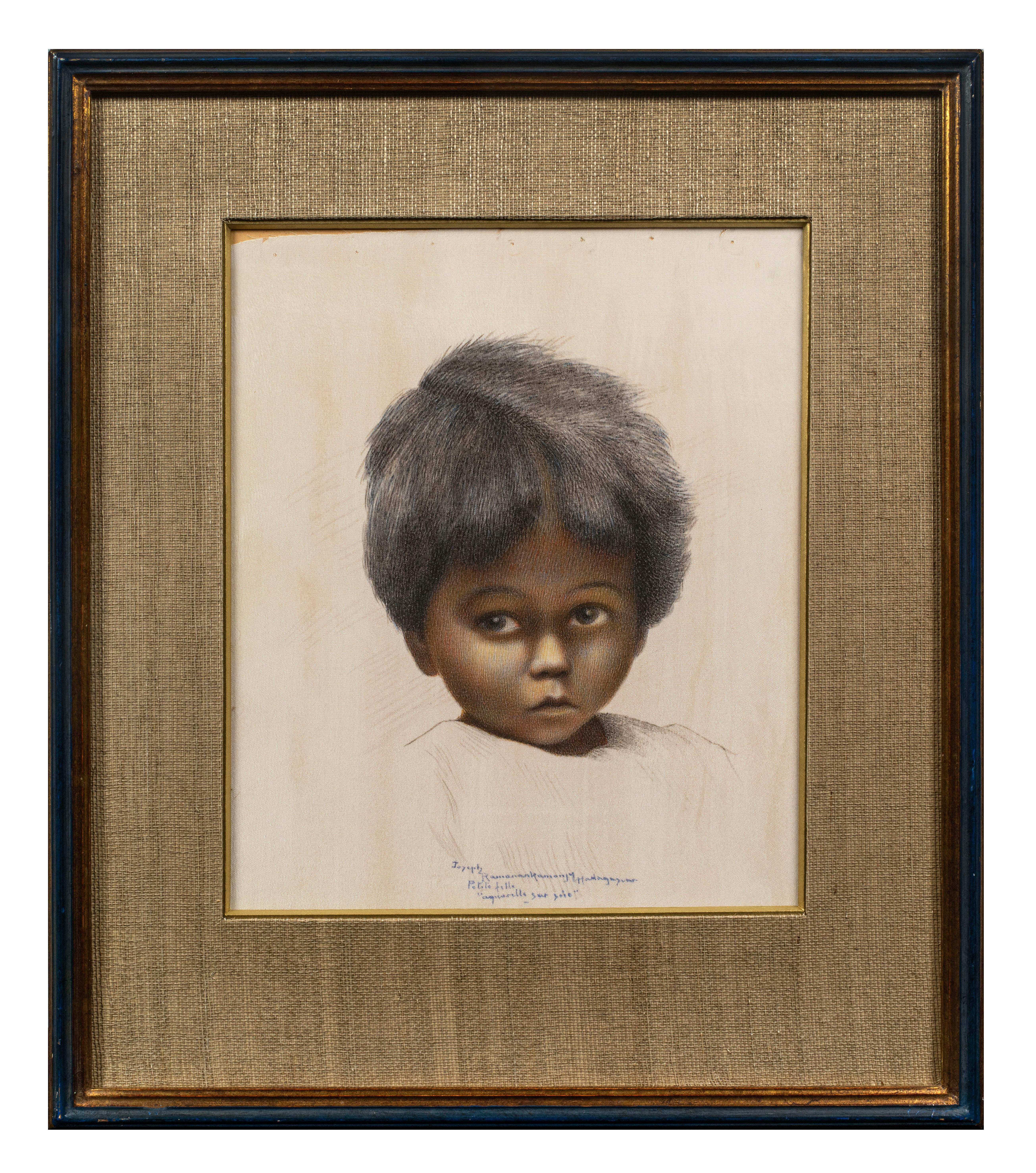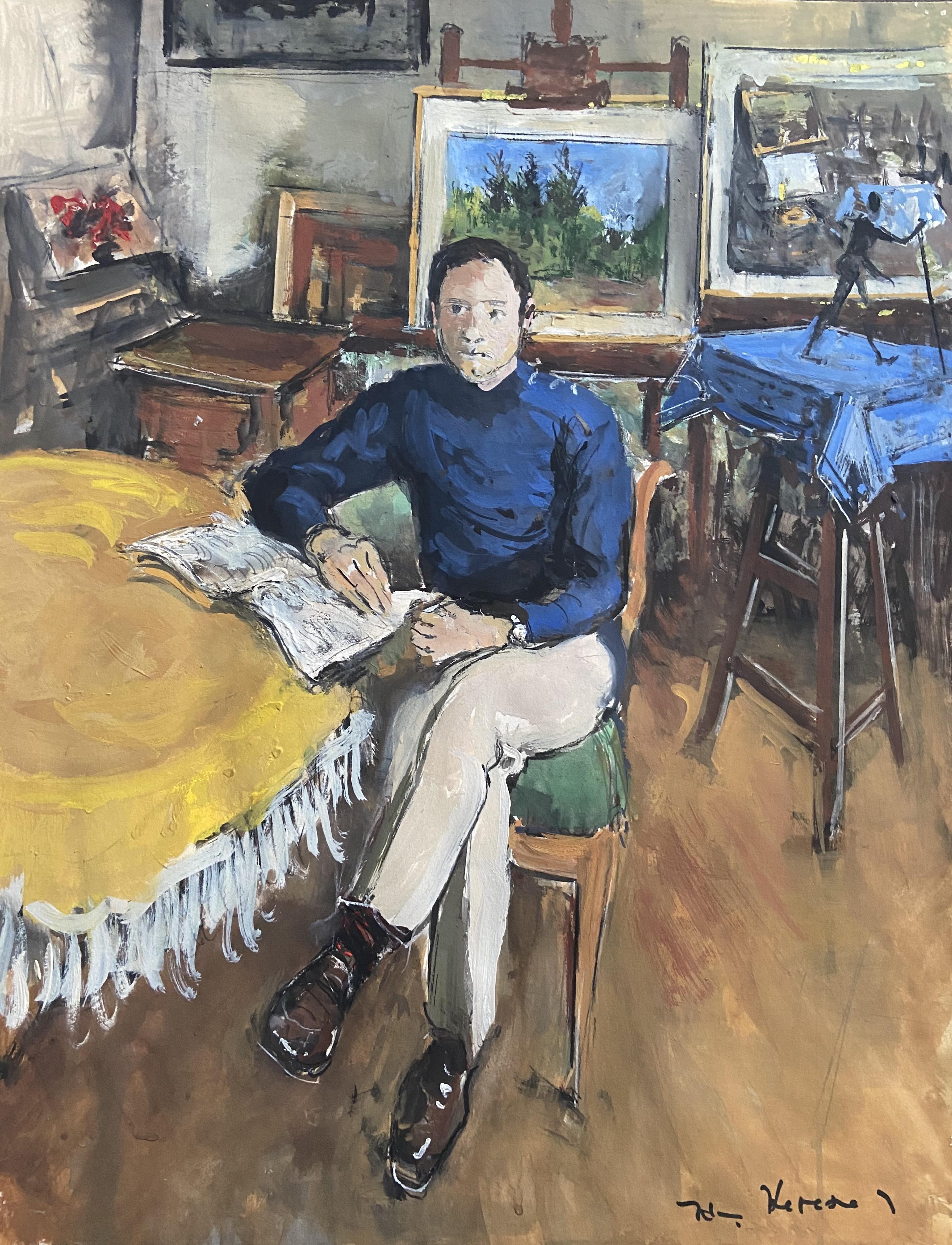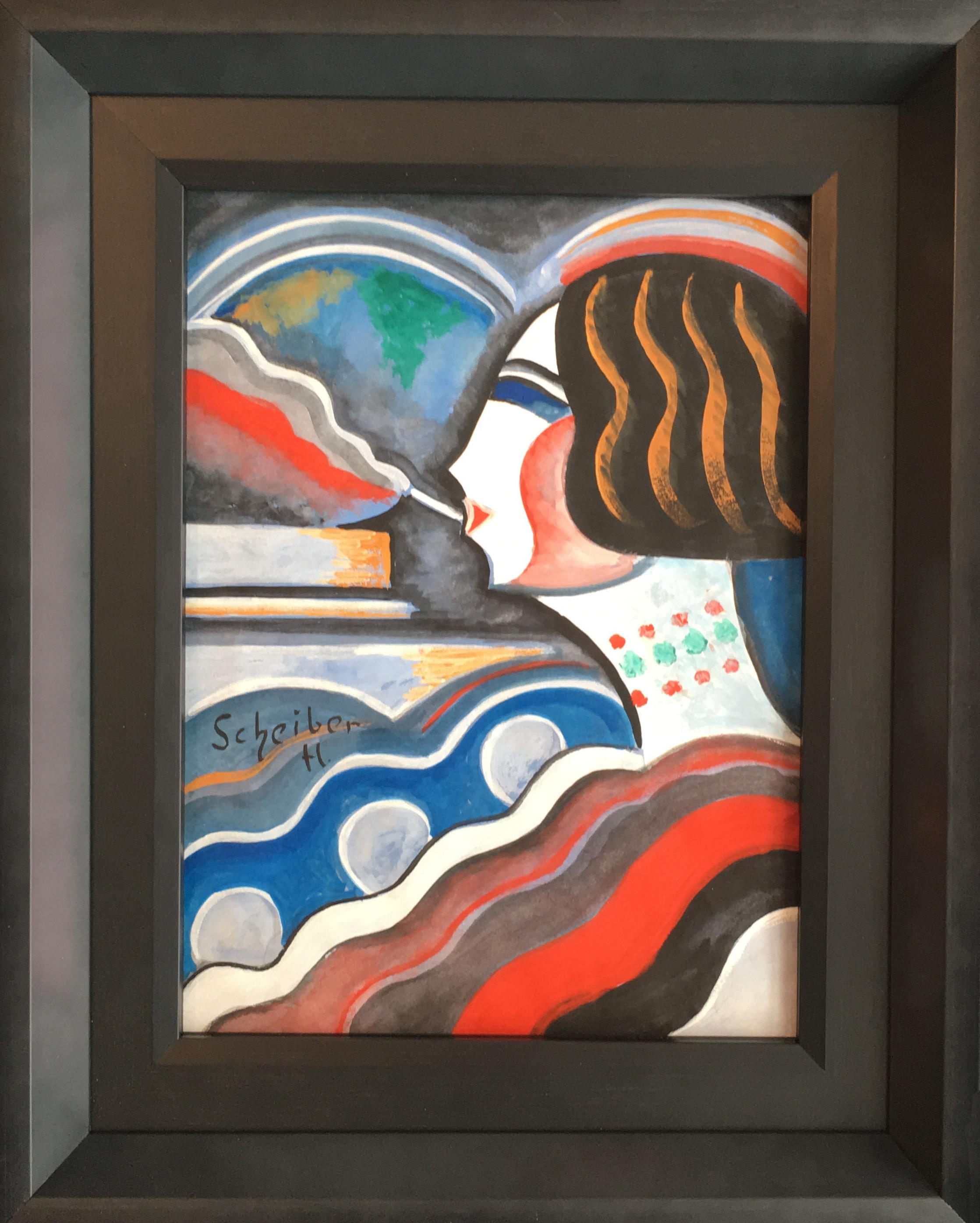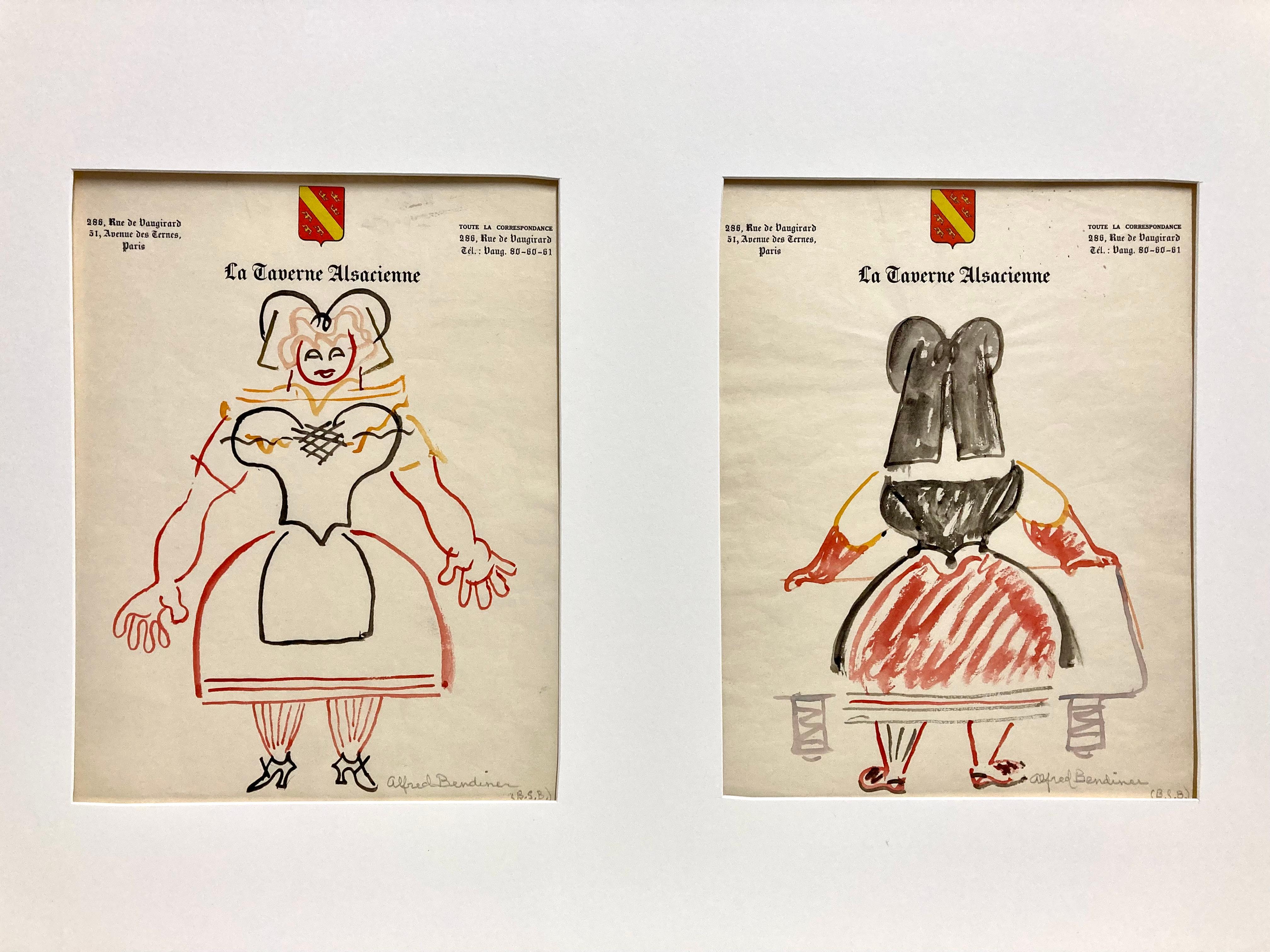Items Similar to Pierre Olivier Dubaut (1886-1968) Portrait of an artist, watercolor
Video Loading
Want more images or videos?
Request additional images or videos from the seller
1 of 14
PIERRE OLIVIER DUBAUT Pierre Olivier Dubaut (1886-1968) Portrait of an artist, watercolorcirca 1930
circa 1930
About the Item
Pierre Olivier Dubaut (1886-1968)
Portrait of an artist
Stamp of the artist on the lower part
watercolor on paper
46.5 x 30 cm
In a vintage frame : 58 x 42 cm, some damages in the mat at the uppper right, see detail photograph please.
Pierre Olivier Dubaut was born in Paris, he had a great predilection for horses, which he represents in many paintings and watercolors. He etched sometimes on the etch and on the stone. He was a member of several artistic societies, he especially admired Theodore Gericault, he had collected a remarkable collection of drawings and watercolors and also some paintings by this painter. He collected also drawings by Delacroix and Guys. In collaboration with the late Duke of Treviso, he was preparing a definitive work on Géricault. In addition, he had also a collection of old Masters drawings.
"Pierre Olivier Dubaut is a virtuoso of watercolor, the ideal vehicle for his supple invention and warm spontaneity. With a nimble brush, he seizes without fixing it the life which passes, the fleeting movement, the ephemeral. He suggests the form of an unrepentant, elegant and light stroke: scenes of trenches during the 1914-1918 war, horse races, paddock, polo, bathers seen on the beach of Deauville. Elliptical and limpid washes build the essential. His watercolors appear in several museums, notably in Trouville, Compiègne, Belfort, The Hague..."
Gerald Schurr Pierre Cabanne "Dictionnaire des petits maîtres 1820-1920"
- Creator:PIERRE OLIVIER DUBAUT (1886 - 1968, French)
- Creation Year:circa 1930
- Dimensions:Height: 18.31 in (46.5 cm)Width: 11.82 in (30 cm)
- Medium:
- Movement & Style:
- Period:
- Condition:
- Gallery Location:Paris, FR
- Reference Number:
About the Seller
5.0
Platinum Seller
These expertly vetted sellers are 1stDibs' most experienced sellers and are rated highest by our customers.
Established in 2018
1stDibs seller since 2019
209 sales on 1stDibs
Typical response time: <1 hour
- ShippingRetrieving quote...Ships From: Paris, France
- Return PolicyA return for this item may be initiated within 14 days of delivery.
More From This SellerView All
- Jacques Thevenet (1891-1989) Portrait of a man in the studio, signed GouacheBy Jacques ThévenetLocated in Paris, FRJacques Thevenet (1891-1989) Portrait of a man in the studio Gouache on paper Signed lower right 64 x 49 cm Framed 77 x 62 cm, some damages to the frame as visible on the photographs Jacques Thévenet was born in Montquinon 17 October 1891, in the family’s ancestral home, built by his great grand-father, Auguste Hugues Claude Thévenet, lawyer from Château-Chinon. He had 3 sisters and lost his mother in 1895 when he was only four. His father Louis moved the family to Paris where he run a law practice. Young Jacques studied at the Lycée Carnot and later attended the École de droit of the Sorbonne University. Simultaneously, he attended the Académie Julian, with several painters such as Amédée de la Patellière, Jean Crotti...Category
1960s Modern Portrait Drawings and Watercolors
MaterialsGouache
- Paul Gavarni (1804-1866) La Soubrette (The handmaid), watercolorBy Paul Gavarni (Guillaume Sulpice Chevalier)Located in Paris, FRPaul Gavarni (1804-1866) La Soubrette (The handmaid), pencil, watercolor and heightenings of gouache on paper Signed lower right (faded) 20 x 15 cm In quite good condition, lightly sunstroke and yellowed Framed 28.5 x 23 cm Paul Gavarni was the nom de plume of Sulpice Guillaume Chevalier (13 January 1804 – 24 November 1866), a French illustrator, born in Paris. The story is told that he took his name from Gavarnie in Luz-Saint-Sauveur where he had taken a journey into the Pyrenees. He was a very famous illustrator, friend of Felix Nadar...Category
1850s Portrait Drawings and Watercolors
MaterialsWatercolor
- Pierre Olivier DUBAUT (1886-1968) Head studies of a horseman, signed watercolorLocated in Paris, FRPierre Olivier DUBAUT (1886-1968) Head studies of a horseman, Geoffrey Larcher, 1936 Signed lower center Watercolor, black and red chalks and pencil on paper 22 x 27.5 cm Titled an...Category
1930s Art Deco Figurative Drawings and Watercolors
MaterialsWatercolor
- French school circa 1840, Portrait of a Lady, watercolorLocated in Paris, FRFrench school circa 1840 Portrait of a Lady watercolor on Bristol paper 25.5 x 20 cm oval in quite good condition : slightly yellowed by time, multiple little scratches, stains (see ...Category
1840s Old Masters Portrait Drawings and Watercolors
MaterialsWatercolor
- Jules-Eugène Lenepveu (1819-1898) Portrait of a man in profile, signed drawingLocated in Paris, FRJules-Eugène Lenepveu (1819-1898) Portrait of a man in profile signed on the lower right Pencil and heightenings of white gouache on paper 19.5 x 13 cm Framed : 29 x 22.7 cm Jules...Category
1860s Romantic Portrait Drawings and Watercolors
MaterialsGouache, Pencil
- French school 19th century, An italian bandit, 1864, watercolorLocated in Paris, FRFrench school 19th century, An italian bandit, 1864, watercolor on paper On the reverse of the sheet (now under the back of the frame) an annotation, "Rome 1864" 25,5 x 21.5 cm (v...Category
1860s Romantic Portrait Drawings and Watercolors
MaterialsWatercolor
You May Also Like
- Chaim Gross Mid Century Mod Judaica Jewish Watercolor Painting Rabbis WPA ArtistBy Chaim GrossLocated in Surfside, FLChaim Gross (American, 1904-1991) Watercolor painting Rabbinical Talmudic Discussion Hand signed 17 x 29 framed, paper 10 x 22 Chaim Gross (March 17, 1904 – May 5, 1991) was an American modernist sculptor and educator. Gross was born to a Jewish family in Austrian Galicia, in the village of Wolowa (now known as Mezhgorye, Ukraine), in the Carpathian Mountains. In 1911, his family moved to Kolomyia (which was annexed into the Ukrainian USSR in 1939 and became part of newly independent Ukraine in 1991). When World War I ended, Gross and brother Avrom-Leib went to Budapest to join their older siblings Sarah and Pinkas. Gross applied to and was accepted by the art academy in Budapest and studied under the painter Béla Uitz, though within a year a new regime under Miklos Horthy took over and attempted to expel all Jews and foreigners from the country. After being deported from Hungary, Gross began art studies at the Kunstgewerbeschule in Vienna, Austria shortly before immigrating to the United States in 1921. Gross's studies continued in the United States at the Beaux-Arts Institute of Design, where he studied with Elie Nadelman and others, and at the Art Students League of New York, with Robert Laurent. He also attended the Educational Alliance Art School, studying under Abbo Ostrowsky, at the same time as Moses Soyer and Peter Blume. In 1926 Gross began teaching at The Educational Alliance, and continued teaching there for the next 50 years. Louise Nevelson was among his students at the Alliance (in 1934), during the time she was transitioning from painting to sculpture. In the late 1920s and early 1930s he exhibited at the Salons of America exhibitions at the Anderson Galleries and, beginning in 1928, at the Whitney Studio Club. In 1929, Gross experimented with printmaking, and created an important group of 15 linocuts and lithographs of landscapes, New York City streets and parks, women in interiors, the circus, and vaudeville. The entire suite is now in the collection of the Philadelphia Museum of Art. Gross returned to the medium of printmaking in the 1960s, and produced approximately 200 works in the medium over the next two decades. For more than sixty years Chaim Gross's art has expressed optimistic, affirming themes, Judaica, balancing acrobats, cyclists, trapeze artists and mothers and children convey joyfulness, modernism, exuberance, love, and intimacy. This aspect of his work remained consistent with his Jewish Hasidic heritage, which teaches that only in his childlike happiness is man nearest to God. In March 1932 Gross had his first solo exhibition at Gallery 144 in New York City. For a short time they represented Gross, as well as his friends Milton Avery, Moses Soyer, Ahron Ben-Shmuel and others. Gross was primarily a practitioner of the direct carving method, with the majority of his work being carved from wood. Other direct carvers in early 20th-century American art include William Zorach, Jose de Creeft, and Robert Laurent. Works by Chaim Gross can be found in major museums and private collections throughout the United States, with substantial holdings (27 sculptures) at the Hirshhorn Museum and Sculpture Garden. A key work from this era, now at the Smithsonian American Art Museum, is the 1932 birds-eye maple Acrobatic Performers, which is also only one and one quarter inch thick. In 1933 Gross joined the government's PWAP (Public Works of Art Project), which transitioned into the WPA (Works Progress Administration), which Gross worked for later in the 1930s. Under these programs Gross taught and demonstrated art, made sculptures that were placed in schools and public colleges, made work for Federal buildings including the Federal Trade Commission Building, and for the France Overseas and Finnish Buildings at the 1939 New York World's Fair. Gross was also recognized during these years with a silver medal at the Exposition universelle de 1937 in Paris, and in 1942, with a purchase prize at the Metropolitan Museum of Art's "Artists for Victory" exhibition for his wood sculpture of famed circus performer Lillian Leitzel. In 1949 Gross sketched Chaim Weizmann, Israeli President, at several functions in New York City where Weizmann was speaking, Gross completed the bust in bronze later that year. Gross returned to Israel for three months in 1951 (the second of many trips there in the postwar years) to paint a series of 40 watercolors of life in various cities. This series was exhibited at the Jewish Museum (Manhattan) in 1953. He also did some important Hebrew medals. In the 1950s Gross began to make more bronze sculptures alongside his wood and stone pieces, and in 1957 and 1959 he traveled to Rome to work with famed bronze foundries including the Nicci foundry. At the end of the decade Gross was working primarily in bronze which allowed him to create open forms, large-scale works and of course, multiple casts. Gross's large-scale bronze The Family, donated to New York City in 1991 in honor of Mayor Ed Koch, and installed at the Bleecker Street Park at 11th street, is now a fixture of Greenwich Village. In 1959, a survey of Gross's sculpture in wood, stone, and bronze was featured in the exhibit Four American Expressionists curated by Lloyd Goodrich at the Whitney Museum of American Art, with work by Abraham Rattner, Doris Caesar, and Karl Knaths. In 1976, a selection from Gross's important collection of historic African sculpture, formed since the late 1930s, was exhibited at the Worcester Art Museum in the show The Sculptor's Eye: The African Art Collection of Mr. and Mrs. Chaim Gross. Gross was elected into the National Academy of Design as an Associate member, and became a full Academician in 1981. In 1984, he was inducted into the American Academy of Arts and Letters, with Jacob Lawrence and Lukas Foss. In the fall of 1991, Allen Ginsberg gave an important tribute to Gross at the American Academy of Arts and Letters, which is published in their Proceedings. In 1994, Forum Gallery, which now represents the Chaim Gross estate, held a memorial exhibition featuring a sixty-year survey of Gross's work.In March 1932 Gross had his first solo exhibition at Gallery 144 in New York City. For a short time they represented Gross, as well as his friends Milton Avery, Moses Soyer, Ahron Ben-Shmuel and others. Gross was primarily a practitioner of the direct carving method, with the majority of his work being carved from wood. Other direct carvers in early 20th-century American art include William Zorach, Jose de Creeft, and Robert Laurent. Works by Chaim Gross can be found in major museums and private collections throughout the United States, with substantial holdings (27 sculptures) at the Hirshhorn Museum and Sculpture Garden. A key work from this era, now at the Smithsonian American Art Museum, is the 1932 birds-eye maple Acrobatic Performers, which is also only one and one quarter inch thick. In 1933 Gross joined the government's PWAP (Public Works of Art Project), which transitioned into the WPA (Works Progress Administration), which Gross worked for later in the 1930s. Under these programs Gross taught and demonstrated art, made sculptures that were placed in schools and public colleges, made work for Federal buildings including the Federal Trade Commission Building, and for the France Overseas and Finnish Buildings at the 1939 New York World's Fair. Gross was also recognized during these years with a silver medal at the Exposition universelle de 1937 in Paris, and in 1942, with a purchase prize at the Metropolitan Museum of Art's "Artists for Victory" exhibition for his wood sculpture of famed circus performer Lillian Leitzel. In 1949 Gross sketched Chaim Weizmann, President of Israel, at several functions in New York City where Weizmann was speaking, Gross completed the bust in bronze later that year. Gross returned to Israel for three months in 1951 (the second of many trips there in the postwar years) to paint a series of 40 watercolors of life in various cities. This series was exhibited at the Jewish Museum (Manhattan) in 1953. In the 1950s Gross began to make more bronze sculptures alongside his wood and stone pieces, and in 1957 and 1959 he traveled to Rome to work with famed bronze foundries including the Nicci foundry. At the end of the decade Gross was working primarily in bronze which allowed him to create open forms, large-scale works and of course, multiple casts. Gross's large-scale bronze The Family, donated to New York City in 1991 in honor of Mayor Ed Koch, and installed at the Bleecker Street Park at 11th street, is now a fixture of Greenwich Village. In 1959, a survey of Gross's sculpture in wood, stone, and bronze was featured in the exhibit Four American Expressionists curated by Lloyd Goodrich at the Whitney Museum of American Art, with work by Abraham Rattner, Doris Caesar, and Karl Knaths. In 1976, a selection from Gross's important collection of historic African sculpture, formed since the late 1930s, was exhibited at the Worcester Art Museum in the show The Sculptor's Eye: The African Art Collection of Mr. and Mrs. Chaim Gross. Gross was elected into the National Academy of Design as an Associate member, and became a full Academician in 1981. In 1984, he was inducted into the American Academy of Arts and Letters, with Jacob Lawrence and Lukas Foss. In the fall of 1991, Allen Ginsberg gave an important tribute to Gross at the American Academy of Arts and Letters, which is published in their Proceedings. In 1994, Forum Gallery, which now represents the Chaim Gross estate, held a memorial exhibition featuring a sixty-year survey of Gross's work. Gross was a professor of printmaking and sculpture at both the Educational Alliance and the New School for Social Research in New York City, as well as at the Brooklyn Museum Art School, the MoMA art school, the Art Student's League and the New Art School (which Gross ran briefly with Alexander Dobkin...Category
Mid-20th Century American Modern Figurative Drawings and Watercolors
MaterialsPaper, Watercolor
- Un EnfantBy Joseph RamanankamonjyLocated in New York, NYSigned and inscribed, lower center: Joseph / Ramanankamonjy / un enfant / Madagascar / “sanguine sur soie” Provenance: Private Collection, Paris Private Collection, Florida Sometim...Category
20th Century Modern Figurative Drawings and Watercolors
MaterialsSilk, Watercolor
- Petite FilleBy Joseph RamanankamonjyLocated in New York, NYSigned and inscribed, lower center: Joseph / Ramanankamonjy / Madagascar / Petite fille / “aquarelle sur soie” Provenance: Private Collection, Paris Private Collection, Florida Som...Category
20th Century Modern Figurative Drawings and Watercolors
MaterialsSilk, Watercolor
- Untitled image of woman smoking by modernist painter Hugó ScheiberBy Hugó ScheiberLocated in Hudson, NYThis artwork is framed with non-reflective, UV protection Museum glass. The frame size is 15.5" x 12.75" About this artist: Hugó Scheiber was born in Budapest, Hungary in 1873. His ...Category
Early 20th Century Modern Portrait Drawings and Watercolors
MaterialsTempera, Gouache, Paper
- Alfred Bendiner, La Alsacienne (pair)By Alfred BendinerLocated in New York, NYLeave it to the Bendiners to find an Alsatian restaurant in Paris (La Taverne Alsacienne) and use it's stationary to such a great end! And thank goodness that the paper required two ...Category
1960s American Modern Figurative Drawings and Watercolors
MaterialsWatercolor
- Interracial Love - New York City Street Scene - Proposition - Red Light DistrictBy Philip ReismanLocated in Miami, FLIn the 1970s, the Times Square/ Mid-Town area of New York City was a gritty place of X-rated movies, Strip Bars, Pimps, Street Walkers, and cheap by-the-hour Hotels. The place was a...Category
1970s Modern Figurative Drawings and Watercolors
MaterialsWatercolor
Recently Viewed
View AllMore Ways To Browse
Pierre Artist
Old Master Drawings
Vintage Artist Brushes
Vintage Artists Brushes
Watercolour Brushes
Old Vintage Portrait Paintings
Etch Drawings
War Horse
Modern Vintage Portrait Painting
Portrait Etch
Beach Scene Watercolor
Vintage Watercolor Artists
Vintage Watercolor Paintings
Vintage Races
Deauville Vintage
Vintage Drawing Beach
Polo Horse
Invention Photograph
